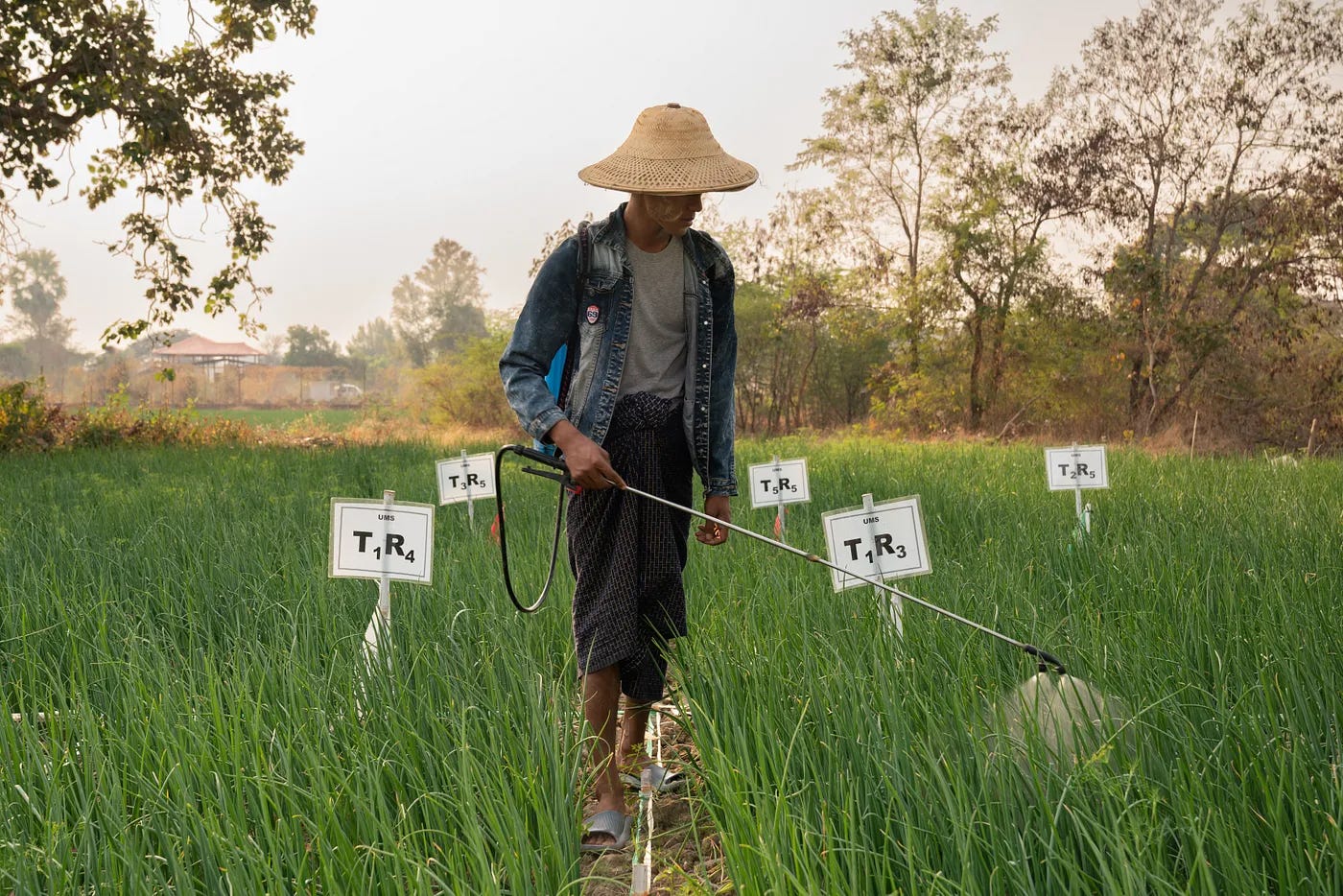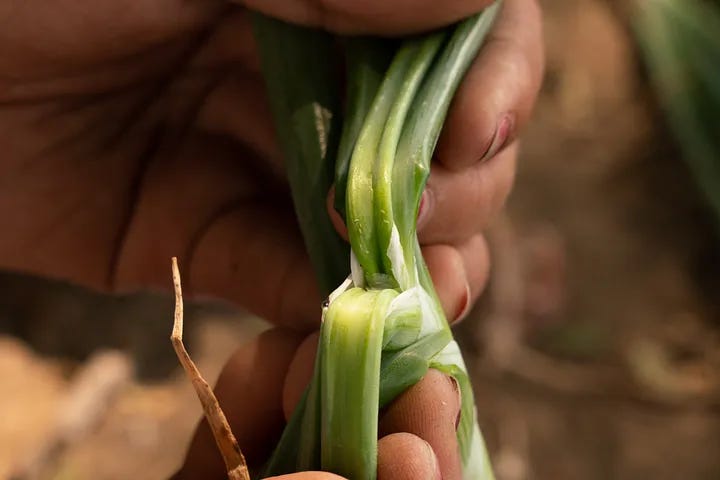A Rare Win-Win-Win in Myanmar Agriculture…
Organic alternatives boost income, reduce environmental destruction, and help mitigate climate change

This week, I’m reproducing a blog from Proximity Designs, an award-winning social enterprise whose work I’ve admired for years. It designs products and services for rural families in Myanmar and I wanted to share what it has been able to do despite the tremendous challenges.
I also thought it is very timely, given the heated debate in Europe over Nature Restoration Law this week, which survived a parliamentary vote by the skin of its teeth. The din of misinformation before the vote was cacophonous, coming from many places, including centre-right politicians who portrayed efforts to protect nature as a cultural war that will lead to hunger and malnutrition.
Ironically, farmers in Myanmar, home to an ongoing humanitarian crisis, are showing these politicians that food production and environmental protection need not be mutually exclusive. Original blog can be found here. It has been lightly edited.
It has been a long time since many of Myanmar’s farmers last encountered an earthworm while preparing their land. Buffeted by climate change and ecological imbalances, smallholders have become increasingly dependent on chemical pesticides to protect their crops amid falling yields.
That has been bad news for the creatures that live in arable soils, but over the past two years some farmers have noticed the return of the humble worm to their fields. This is thanks, in part, to a fungus called Trichoderma, which can be used as a substitute for pesticides and chemical fertilisers, allowing farmers to use less of such inputs.
Trichoderma also boosts crop yields by an average of 17% which could boost farmers’ income, on average, by a whopping $50/acre each harvest, according to our impact assessment. (Note: I mistakenly used $0.50/acre in the original issue)
There is an urgent need in Myanmar and around the world for affordable and environmentally friendly alternatives to harmful agrochemicals. Global fertiliser prices are at historically high levels due to the ongoing war in Ukraine and international sanctions on Russia’s fertiliser exports.
Meanwhile, locally, Myanmar’s currency has devalued by half (since March 2020). This is a big burden in a country where 80% of inputs are imported. This has resulted in smallholders paying up to four times the cost for chemical inputs, compared to three years ago.
Surging Demand
As they struggle to afford inputs, Myanmar’s smallholders are farming fewer acres and seeing their profits squeezed.
Applying Trichoderma costs no more 30,000MMK per acre (equivalent to $12) while chemical fungicide costs triple or quadruple that. At the same time, Trichoderma enables more efficient uptake of soil nutrients, so farmers get more from the fertilisers they use, and encourages growth of beneficial organisms, which reduces pest and disease outbreaks.
The feedback we have received from farmers using biologicals has been overwhelmingly positive. Over 20,000 smallholders have purchased Trichoderma to date. Sesame farmers have been especially happy with the results, with many saying the benefits of applying Trichoderma even carry over to the next season. Chili farmers say their crops are producing fruit for up to two months longer than before.

Shaping the Market
Despite the clear economic benefits, the market for biologicals in Myanmar remains nascent. Generally, there is low awareness of the product category, and some farmers have the misconception that they are not as effective as chemical inputs. The few biologicals that are available in the country are made domestically, and have varying quality due to underinvestment in production facilities.
One issue is that they do not contain enough of the active ingredient (microbes), either because they weren’t well-cultivated or because they have passed their expiry dates.
We began introducing and distributing Trichoderma in solid form in 2020. Now, we plan to ramp up production and distribution as we roll out a range of agricultural biologicals that improve yields and soil quality, boost soil carbon sequestration and prevent pests and diseases.
In addition, we see an opportunity to set quality standards in the market, while catalysing demand for various biologicals and encouraging other businesses to supply them. The fact that a handful of small enterprises have started to sell biologicals since we introduced Trichoderma is encouraging, and supports our thesis that there is a viable market for biological alternatives to costly chemical inputs.
Unlike imported agrochemicals, Trichoderma can be manufactured with locally sourced waste materials, including rice husks, as a substrate. Fish Amino Acid fertilisers are also made from byproducts that local fish farms usually throw away. Amid volatile currency markets, import regulations, and rising material costs, it is more important than ever to invest in supply chains that are both domestic and circular.
Local Innovations, Global Implications
Even amid the immense challenges Myanmar is facing, our Design Lab team is working hard to bring valuable innovations to market. We’ve established a microbiology lab to conduct R&D on new products and decide which will have the most impact. The lab is working on a liquid version of Trichoderma with a longer shelf life, which will help alleviate distribution and supply issues.
Whereas the solid powder form of the fungus has an average shelf life of around a month, we hope the new liquid version will last at least three months, and potentially up to six.
Other biologicals that the lab is looking into include EM, or Effective Microorganisms, which are blends of microorganisms in a carbohydrate-rich substrate that improve soil health and crop yields. Also on our new product pipeline is Rhizobium, a genus of soil bacteria that lives inside roots and fixes nitrogen as part of a symbiotic relationship with the plant. Then, there are Amino Acids, which are abundant in nutrients and a good source of nitrogen for crops.
When necessary and possible, we’ll partner with a local supplier to bring a product to market. Any externally manufactured biologicals will still be subject to our stringent testing standards and due diligence measures.
With a strong product line in place, we’ll take advantage of our vast distribution network, as well as the hard-earned trust we’ve built with farmers, to spur adoption nationwide. We have a track record of offering new products that cut farm costs and labor while boosting profits; many farmers who would otherwise have been skeptical of switching to biologicals are now willing to give them a try.
We look forward to extending the reach of our R&D work, beyond Myanmar’s borders. We’ll share our research on biologicals as well as on a range of holistic farm solutions, with organisations working with smallholders in other parts of the world.
The challenges facing Myanmar’s agricultural sector are global, and we must take collective action to scale impact and support communities affected by growing inequality, conflict, poverty and environmental degradation.
Climate Champions
While the challenge is immense, biologicals are an opportunity for smallholders to strengthen their arsenals in the fight against climate change and biodiversity loss. Food and agriculture account for a third of all global greenhouse gas emissions and are the main cause of soil degradation and biodiversity loss. Smallholders in Myanmar are critical caretakers of the country’s resources of soils, water and ecosystems, with 20% of the land being used for agriculture.
Climate change has continued to have a severe impact on the livelihoods of Myanmar’s farmers. Rainfall has become very erratic, monsoons now start later and finish earlier than before, and pests that used to be a minor problem have become major ones.
The farm families we work with are keenly aware of how dependent their livelihoods are on environmental health, and want access to resources that will help them farm more sustainably without hurting their farm incomes.
Farmers don’t want to sit on the sidelines. They are intimately tied to their lands and want to be active participants in restoring them and reversing the effects of the climate and environmental crisis. Biologicals will be key in equipping farmers for this role.
“I plan to continue farming for many years to come. So, I am glad to find a natural way that reduces pest and disease outbreaks during the season and that is beneficial for the long-term,” said Arkar Soe from Bago region, one of our Trichoderma customers.
With these nature-positive alternatives in hand, Myanmar’s smallholders will be boosting their yields, building a future for their families and championing for the well-being of the planet.
Three Good Reads
The EPP Group is wrong. The EU's nature restoration law won't lead to a 'global famine' - Euronews
Like I said at the top, it was interesting to see the European Parliament's largest political group arguing against restoring nature and making European farming more sustainable.
This op-ed by IPES-Food experts breaks down all that is wrong with their claims, which include the trope that more food produced = lower levels of hunger. The past half a century is proof that this is absolutely NOT true.
How much nitrogen does corn get from fertiliser? Less than farmers think - Phys.org
Very timely piece, given this week’s topic both for Thin Ink and the European Union.
This write-up, based on recent studies from the University of Illinois Urbana-Champaign, said corn takes up the majority of its nitrogen - about 67% on average - from sources occurring naturally in soil, not from fertiliser.
UN numbers say meat is bad for the climate. The reality is worse. - Vox
Sophie Kevany looks into why the most recent estimates by the FAO, the UN food and agriculture agency, on livestock’s share of total annual greenhouse gas emissions have gone down, to 11 % from 14.5%.
Spoiler alert - it’s not because we are getting better at reducing emissions from animal agriculture, but more because of a change in the way these things are measured.
As always, please feel free to share this post and send tips and thoughts on mastodon @ThinInk@journa.host, my LinkedIn page, twitter @thinink, or via e-mail thin@thin-ink.net.








So happy to see you highlight the work of Proximity! I was lucky enough to be on the ground with them in 2007 in Yangon and the Shan State, so I'll always be a fan. So encouraging to see their good work continuing.
What a great read. It's a reminder that even in the most difficult of conditions, people keep on doing great work to help protect the planet.